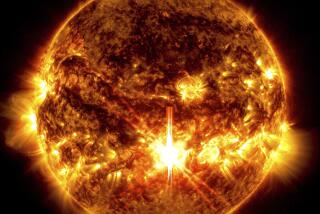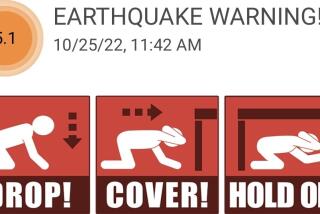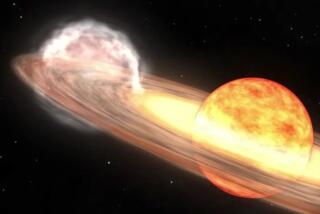Weather Conditions May Obscure View of Eclipse : Astronomy: Dense marine layer along Southland coast, clouds in Hawaii expected.
Weather is likely to hinder eclipse viewing this morning in both Southern California, which will experience a partial solar eclipse and Hawaii, where a total eclipse will take place.
If you want to see the eclipse locally this morning, it’s best to be at least 10 miles inland or head for the mountains or the desert.
A dense marine layer is expected to obscure the view all along the southern coast, from Santa Barbara to the tip of Baja, and it is not likely to burn off until after the eclipse is over, according to forecasters at WeatherData Inc., which provides The Times’ weather information.
If you haven’t already bought a solar filter or special glasses to view the partial eclipse, you’re probably out of luck. Optical supply companies and museum shops say they have been overwhelmed by demand for the special filters and have completely sold out their stocks.
“There’s a tremendous shortage of this stuff,” said Mark Tracy of Los Angeles Optical Co. “The response was absolutely astounding to everybody involved in astronomy, especially in a period of recession. Nobody predicted it right.”
If you don’t have special goggles and don’t want to build your own apparatus to view the partial eclipse--which will be at its height in Los Angeles for five minutes beginning at approximately 11:27, when the moon will block 74% of the sun--your safest bet will be to go to either Griffith Observatory or Mt. Wilson Observatory.
Both will have programs highlighting the eclipse and will have special equipment set up for the public to view the astronomical event. Heavily filtered telescopes and binoculars will project images of the sun onto screens for safe viewing. Griffith Park will open at 9 a.m., Mt. Wilson at 10.
In no case, however, should you look directly at the sun, experts warn. Even at the height of the eclipse, the sun’s rays can permanently damage the retina in just a few seconds, and this damage is irreversible.
If you can’t attend one of the shows and don’t have access to special glasses, you can construct a pinhole camera with just two pieces of cardboard to provide safe viewing. Punch a one-eighth-inch hole in one card, and allow sunlight to shine through it and fall on the second, held two to three feet behind it.
Alternatively, you can punch a small hole in one end of a cardboard box and allow the sun’s image to be projected onto the opposite end. Hold the box over your head to watch.
Under no circumstances should you attempt to view the eclipse through conventional sunglasses, smoked glass or exposed photographic film, experts say. Irregularities in the coatings can allow damaging light rays to pass through.
Welder’s goggles or welder’s glass with a rating of at least 14 can be used safely, however.
Officials of the Los Angeles Unified School District announced Wednesday that children in summer school will be kept indoors during the eclipse for safety reasons.
Eclipse enthusiasts who flew to Hawaii, where the moon will block 100% of the sun for four minutes, may be disappointed. It was raining heavily over much of the Big Island of Hawaii Wednesday afternoon, but it was too early to tell if the clouds would clear in time for the eclipse.
Meteorologist Michael Schlesinger of WeatherData said the skies over the islands will be partly cloudy this morning, creating the possibility that the thousands of tourists who traveled to Hawaii to view the solar spectacle might be thwarted by a persistent cloud cover.
Astronomers who planned to view the eclipse with telescopes atop the Mauna Kea volcano may be thwarted not only by the cloud cover, but also by dust and ash injected into the upper atmosphere by the recent eruption of Mt. Pinatubo in the Philippines.
At least three of nine planned experiments will not be affected, said astronomer Donald N.B. Hall of the University of Hawaii. “For the other six, we expect some impact, but we don’t know enough about the dust to determine what effect it will have. . . . It could really disrupt the plans of the 50 astronomers selected by international competition to use the big telescopes on the mountain.”
Tourist traffic into the Big Island was considerably less than had been anticipated. Many of the planes flying in were less than half full, and ports along the coast reported fewer yachts and pleasure boats than had been expected.
The worst viewing of all may occur in inland Mexico and Central America, where the rainy season is in full sway. Tourists and scientists there may see little more than a six-minute soggy blackness with a biting 50 degrees Fahrenheit temperature plunge to boot, Mexican officials say.
The alignment of the Earth, moon and sun will also produce unusually high tides in Southern California. The highest high tide today will be 7.8 feet at 9:41 p.m. in San Diego. It is the highest tide this year and there will be no higher tides through the rest of this century.
In Los Angeles, tides will average about 7.2 feet at 9:28. Property damage could occur in low-lying areas along the coast if high waves accompanied the tides, but the National Weather Service is not predicting such waves.
Times science writer Lee Dye, in Hawaii to cover the eclipse, contributed to this story.
How to Watch the Eclipse
The eclipse will begin here today at 10:12 a.m. and end about 12:46 p.m. At its height in Los Angeles, the eclipse will block 74% of the sun for about five minutes, at approximately 11:27 a.m.
Pinhole Camera
* If you don’t have access to welder’s goggles or a special filter, the easiest way to view the eclipse is with a pinhole camera.
* To make a pinhole camera, use two sheets of cardboard.
* Puncture a small hole in one sheet, to allow sunlight to pass through and fall onto the second sheet, which you should hold two to three feet away.
More to Read
Sign up for The Wild
We’ll help you find the best places to hike, bike and run, as well as the perfect silent spots for meditation and yoga.
You may occasionally receive promotional content from the Los Angeles Times.






